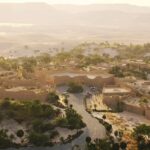We spoke to CCG’s UAE Area Manager, Hazem Haddad about what Dubai’s new 3D-printing construction target might mean for designers and architects.
3D printing is a technology that allows 3D objects to be printed from a digital design by building up layers of material. In recent years, this technology has become increasingly accessible and it is now gaining popularity in the construction industry.
Large 3D printers that can use concrete type materials can be used in construction to create structural components and entire buildings. Components can be printed and then shipped to the building site to be constructed and reinforced, or the printer can be used on site to print on demand. This provides opportunity to create large scale projects quickly and at a lower cost than regular construction with less wasted materials.
A range of building materials can be used such as a special stronger type of concrete, dry powder cement that is printed in layers and then sprayed with water to solidify, or scaffolding can be printed that is later filled to create walls, beams and more. Bio-renewable materials are currently being tested for use in construction, too.
We have recently seen the world’s first 3D printed school open in Malawi, which took only 18 hours to print. In countries like Malawi, this quick speed of construction can be especially effective in addressing infrastructure needs.
In Dubai, UAE, a decree has been issued to regulate the use of 3D printing in the construction sector. This will support the national target for 25% of all new buildings to be constructed using 3D printing technology by 2030, with the intention for Dubai to become a global leader for 3D printing technologies.
The UAE has also unveiled the world’s largest 3D printed building, at 9.5m tall with an area of 640m2. It was printed using an on-site machine that mixed materials together before arranging into thin layers that solidified almost immediately into concrete, while the foundation used both conventional and 3D printing methods. Officials said that the building has passed all safety checks, provides the same amenities and is as durable as conventional buildings.
Buildings created using this technology have a lower cost, quicker construction and reduced environmental footprint compared to buildings constructed using traditional methods, which may be enough of an explanation for why the UAE is eager to increase its use of this technology, especially being a country with such a booming construction industry.
CCG’s UAE Area Manager, Hazem Haddad, believes there is great potential for the 3D printing industry to grow.
The technology will not just be used to print construction materials, but also equipment and forms or molds that will be used to produce other construction materials.
“The same way that BIM changed how architects create new schemes, 3D printing will influence designers’ imaginations regarding design and construct methodology. Although some may consider the quicker speed of construction to be the main advantage, in the minds of most architects, the key focus should still remain as what this technology will allow for creativity.”
How will design firms align their strategies with the UAE’s plan in regards to construction technology?
Hazem’s expectation is that this technology will allow for fast and easy reallocation of architectural elements in the future, just like building blocks, where the spaces are able to easily be manipulated and customized to suit the end user’s lifestyle.
“We may see new practices of construction appear, where one block is built at a time of a larger construction site as part of an ongoing process to achieve adaptable outcomes with much higher involvement from end users. This would mean that users will not have to read construction drawings, but instead actively participate during the project’s construction. A hard-hitting approach contractually, but this could be the reality soon. Smart designers will convert their ideas and sketches into hard models that will help to achieve better client visualization, selection, crisp idea conception as well as other benefits.”
Are we going to see this trend for 3D printed buildings spreading further across the MENA region?
“Most probably, yes – particularly in commercial construction and in low to medium income communities.”
There are areas within the MENA region that Hazem sees as showing high potential to benefit from the speed of construction that 3D printing technology would offer, due to the economic and political issues of some communities. However, he believes that the mindset of local residents may prevent this technology being used yet in higher-end construction projects, at least for a few more years to ensure that higher quality and more advanced printing equipment and materials will be used.
Will Dubai’s plan create limitations or constraints for designers in terms of creativity and using different materials and structures?
Perhaps within the first few years this may be the case, until further development is achieved. However eventually, Hazem thinks that the technology should enhance creativity instead of limiting it, as a lot of constructability issues that designers currently face will be resolved by then.
“The opportunities brought about by 3D printing shall enrich how architects think and can help them to produce more accurate and complex construction elements.”
Are we likely to see CCG’s architects and designers working with 3D printing technology in the near future?
Yes, at CCG, our goal is to ensure the latest and most beneficial technologies are being utilized at optimal usability.













